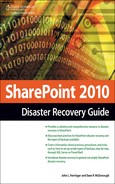Book Description
Microsoft's SharePoint platform is a complex, diverse technical tool designed to meet a range of business needs and uses. It requires several other platforms and applications for implementation, and it can be integrated with other external line of business applications. This diversity also applies to the numerous methods, tools, and approaches that can be used to preserve your SharePoint farm if it becomes affected by a catastrophic event. The majority of SharePoint 2010 Disaster Recovery Guide introduces you to those methods, tools, and approaches for backing up and restoring SharePoint. After it covers all the crucial technical aspects of preserving SharePoint with the tools Microsoft provides for it, it introduces you to the key concepts and activities necessary to develop a disaster recovery plan to implement those technical practices.
Table of Contents
- Copyright
- Acknowledgments
- About the Authors
- Introduction
- 1. SharePoint Disaster Recovery Planning and Key Concepts
- 2. SharePoint Disaster Recovery Design and Implementation
- 3. SharePoint Disaster Recovery Testing and Maintenance
- 4. SharePoint Disaster Recovery Best Practices
- 5. Windows Server 2008 Backup and Restore
- 6. Windows Server 2008 High Availability
- Load Balancing
- High Availability
- Conclusion
- 7. SQL Server 2008 Backup and Restore
- 8. SQL Server 2008 High Availability
- 9. SharePoint 2010 Central Administration Backup and Restore
- Getting Started
- An Overview of Backup and Restore Capabilities
- Backup/Restore Prerequisites and Considerations
- Backing Up from Central Administration
- Restoring Within Central Administration
- Conclusion
- 10. SharePoint 2010 Command Line Backup and Restore: PowerShell
- 11. SharePoint 2010 Disaster Recovery Development
- Hey Administrator—I’m Talkin’ to You!
- The SharePoint Object Model
- Volume Shadow Copy Service
- Rolling Your Own Backup and Restore Approach
- Designing Applications for Disaster Recovery Readiness
- Conclusion
- 12. SharePoint 2010 Disaster Recovery for End Users
- 13. Conclusion
